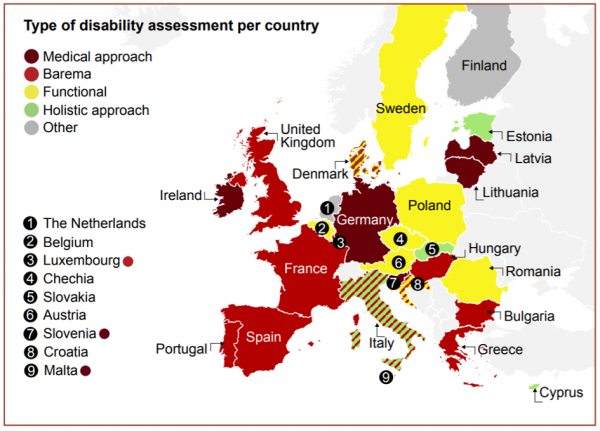Disability Assessment and Social Protection
Introduction
We work with our members to try to improve how people in Europe are assessed to be certified as having a disability. We call this “Disability assessment”. We also work on trying to increase the support and the disability allowance (financial assistance) that persons with disabilities receive. We refer to these using the general term of “Social Protection”, which is covered by Article 28 of the UN Convention on the Rights of Persons with Disabilities (UN CRPD).
Disability assessment and social protection are decided at national or regional level. This means that the European Union is not responsible for this area. We advocate for EU action in the following ways:
- Pushing for mutual recognition of disability assessment between EU Member States so that people can be recognised as having a disability when moving to another EU country;
- Advocating for recommendations on social protection to the Member States as part of the European Semester. This European Semester is a 6 month cycle of revision of national policies, including social policies. We argue for the need for sufficient disability allowance to ensure persons with disabilities do not live in poverty, as well as the right for people to retain full disability allowance and support if they start paid work or get married, etc;
- Persuading the EU to invest funds in strengthening social protection schemes for persons with disabilities.
Disability Assessment
The method for assessing disability, granting benefits, and providing social protection to citizens with disabilities varies substantially by Member State. To be compliant with the UN CRPD, disability assessment should take environmental factors into account. It should explore how these factors hinder the person’s full and effective participation in society on an equal basis with others.
The methods typically used to assess people are the following:
- Medical approach: Involves procedures relying on medical assessment and does not take account of the needs of the person being assessed.
- The Barema method: A list or table, divided into chapters covering physical or mental components of the body. It gives guidance on medical benchmarks against which assessments should be made for each of these components. On this basis, a “percentage of disability” is declared. For example, the loss of an eye might account for 40% disability and the amputation of a foot for 30% disability[i]. The overall “percentage of disability” will be the impairment ratings for all different parts of the body combined.
- Functional capacity assessment: Seeks to establish functional limitations. It involves identifying the abilities and inabilities of an individual. The assessment may involve standardised tests which measure performance and the ability of an individual to perform certain activities.
- Holistic approach: A holistic assessment combines assessments related to impairment, functional capacity and environmental factors, which more closely aligns with the CRPD and will aid in its successful implementation.
Here is an overview of the methods used in the 27 EU Member States and the UK:
- Medical approach: Germany, Ireland, Latvia, Lithuania, Malta, Slovenia
- Barema: Bulgaria, France, Greece, Hungary, Portugal, UK, Luxembourg, Spain
- Functional: Austria, Belgium, Czechia, Poland, Romania, Sweden
- Holistic approach: Cyprus, Estonia, Slovakia,
- Other: Finland, Netherlands,
- Barema and Holistic approach: Italy
- Medical and functional: Denmark
- Barema and functional: Croatia

[i] Examples given from the English Barema system: Available at https://rm.coe.int/16805a2a27
Disability Assessment and freedom of movement
The EU treaties provide citizens with what is called freedom of movement: opportunities for mobility in countries other than their own. Today, 17 million EU citizens live and work abroad in another EU country [i]. This mobility, however, is extremely limited for persons with disabilities.
The different disability assessment systems lead to a fractured understanding of what disability is and who qualifies for social protection. A person may qualify as “disabled” in one country but not in another. There is great variance for the process to be registered as disabled and then to begin receiving social support. There are different types of qualifying criteria, assessment methods, assessors and supporting evidence required.
This makes navigating the process and system difficult in one’s home country and even more difficult abroad. If a person with a disability were to move to a new country, it would be difficult for them to register again as disabled and to receive their social protection. It means they may experience time with no social protection at all, as they are often unable to keep their protection from their last country of residence.
While a fully harmonised and transparent system of disability assessment across the EU would be beneficial, this is a long-term goal. In the short and medium term, the problem could be alleviated by the introduction of a system of mutual recognition of the different national systems for persons that are travelling or staying temporarily in another Member State.
[i] Available at: https://europa.eu/euandme/passion/work-and-live-abroad_en
Related documents
- Position paper on Social Protection and the Welfare State: What the EU can do to support persons with disabilities
- Improving Disability Assessment in the EU (2021)
- Human Rights Report on Poverty and Social Exclusion of Persons with Disabilities (2020)
- EDF Statement on Minimum income (2020)
- EDF Position Paper on Social Taxonomy